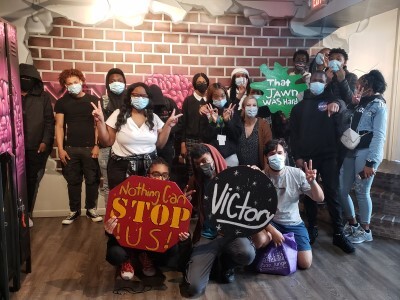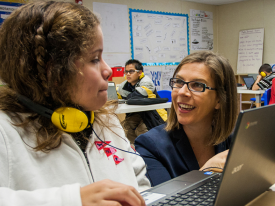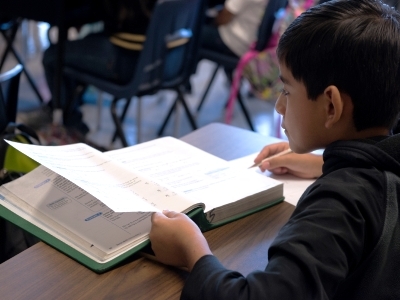Why Aren’t We Talking about Culturally Responsive Education in Next Gen Learning?
Topics

Together, educators are doing the reimagining and reinvention work necessary to make true educational equity possible. Student-centered learning advances equity when it values social and emotional growth alongside academic achievement, takes a cultural lens on strengths and competencies, and equips students with the power and skills to address injustice in their schools and communities.
If next gen learning was truly a force for educational equity, we’d raise the priority of cultural responsiveness. Here’s why.
Those of us in the next gen learning space are ignoring a great opportunity. Something that could propel next gen learning to be the force we say we want it to be: one that fundamentally changes the life trajectories of the students we serve:
Culturally Responsive Education
I’ve been thinking a lot about equity in relation to next gen learning lately. I’m asking tough questions of myself, questioning assumptions in our work instead of letting them go unstudied, thinking about ‘user-centered design’ in a whole new light, and sitting with new information as I try to process and understand it.
The news of recent weeks has been heartbreaking. From the highly publicized police shooting deaths of unarmed Black men, to the shooting spree and deaths of police officers, to the White backlash against Black Lives Matter and, in the education reform world, backlash against empowering people of color to address systemic racism in education, the crack in race relations in this country is opening wider and exposing the problems I knew existed but swept under the rug and out of my consciousness.
My response to this heartbreak: lift up the rug, expose the crack, raise my consciousness, and work to understand what it is underserved students really need. (And, by the way, understand what it is advantaged students need. I wonder if educational equity wouldn’t be better served if higher-income White education reformers—and by that I mean, me—focused more attention on serving advantaged students through social justice education and helping them develop the skills of an ally.)
And then I stumbled upon this:
If students survive their educations, they potentially become widgets—unimaginative, obedient, conforming replicas of each other. Students who do not survive their widget-making education risk higher levels of lifetime poverty and incarceration, as well as poorer physical and mental health outcomes than students exposed to more student-centered educational interventions.
—Diversity Challenge 2016: Race, Culture, and Educating Our Youths – Developing Whole People Not Widgets.
This! Yes! This is why the current system isn’t good enough. And this is why I am so passionate about next gen learning. I believe it can and will help us move away from the ‘lose-lose’ proposition of a factory model, widget-producing school system. It can help us move toward schools that honor students’ individuality and self-authorship by providing meaningful learning experiences that lead to richer, deeper, broader outcomes than proficiency on a test. (What’s the opposite of a widget? A work of art? Or, maybe we need to drop the metaphors and simply say that a student is an individual whose humanity and dignity is celebrated.)

I kept reading:
Racially and culturally responsive student-centered educational systems ought to promote development of whole persons who value themselves and, therefore, contribute to society in positive and meaningful ways. Whole person interventions would incorporate skills and talents that students bring with them from their cultural home environments including language diversity, leadership skills, panache, and social media expertise. They would also address and teach students to recognize and resist institutional and interpersonal racism and ethnoviolence as they are manifested in schools and the environments in which students and their families function.
This incredible description of what schools “ought to” do—what students deserved—is a call for proposals for a diversity conference out of the Institute for the Study and Promotion of Race and Culture, housed at Boston College under the direction of Dr. Janet E. Helms. (October 28-29 if you’re interested.) And it felt like the most authentic equity-minded expression of next gen learning that I have heard or read. I think the reason it resonates is because the authors are starting from a place of equity. Equity, first; how we get there (our answer: next gen learning), second.
Is next gen learning an equitable solution?
If we start with equity first, how would the field of next gen learning measure up? Instead of justifying the equity within next gen learning, can we justify next gen learning in service of equity? If scholars of educational equity looked at our collective theory, principles, and practices, would they find next gen learning—which intends to replace the factory model, claims to serve ALL students, and professes equity as its mission—as leading or lacking?
I lifted up the rug. I looked at documents and websites expressing the guiding principles for our field: design principles, comprehensive lists of student success competencies, calls for proposals, mission statements, school profiles. And here’s the crack:
Culturally responsive education—its absence is widespread and noteworthy.
We claim to value whole person development, but we’re silent on cultural competence and identity development.
We promote learning pathways tailored to individual student’s level of achievement and needs, but where do we advocate for using a cultural lens when creating a learner profile and designing pathways?
And there is no expression within any of the foundational materials I looked at in which “addressing and teaching students to recognize and resist racism and ethnoviolence” is included as a central component of next gen learning.
Let’s start talking about culturally responsive education
If we’re serious about equity, we need to ask ourselves why cultural responsiveness is not as visible and valued as whole person development and personalization within next gen learning.
I know there are educators in our field who embrace cultural responsiveness in their school designs and instructional practices. I’m certain there are next gen school networks, districts, or organizations that incorporate and integrate culturally responsive education into their vision for a new non-widget-producing system. I’m sure that part of the problem is that I’m just not aware of the role cultural responsiveness does play in our collective work.
But that’s my point of concern: Why isn’t it front and center? Why aren’t we talking about it?
Let’s start talking about it and propel next gen learning to be that force for equity we need it to be.
What does it look like in practice when cultural responsiveness is matched with whole person development and personalization? Let’s hear from educators who are helping students develop the ability to recognize and resist racism, ethnoviolence, and other issues we tend to sweep under the rug within a personalized, student-centered, next gen learning environment.
Please share your stories and your ideas by submitting a blog idea.




